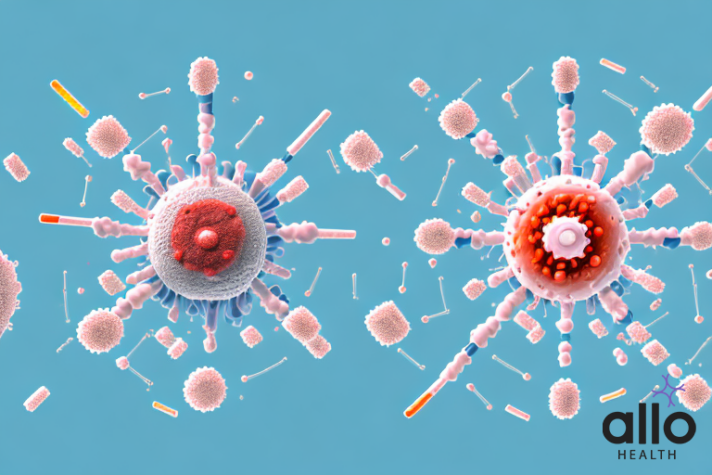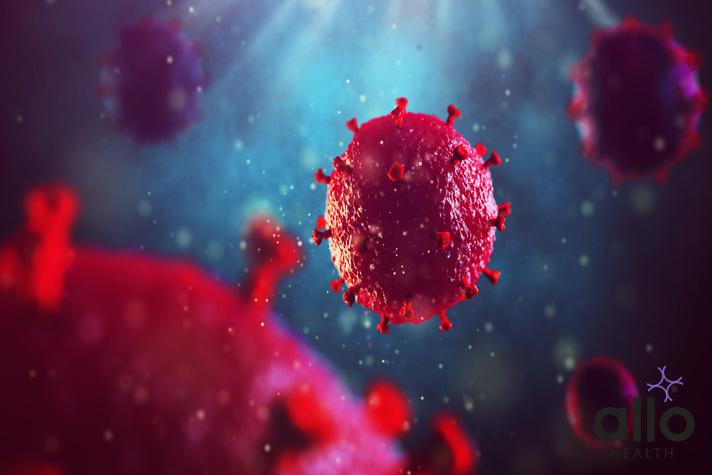HIV Flu vs Normal Flu: Understanding the Differences

Allo Health is dedicated to personalized well-being, offering support and trusted information tailored to individual health goals. The platform emphasizes human-generated content, led by a distinguished medical team of experts, including physicians and sexual health specialists. Their commitment to credibility involves rigorous fact-checking, authoritative research, and continuous updates to ensure accurate, up-to-date information. Allo Health's unique approach goes beyond conventional platforms, providing expert-led insights and a continuous commitment to excellence, with user feedback playing a crucial role in shaping the platform's authoritative voice.

Dr Sanina Mansoor holds MBBS degree from Yenepoya university,Mangalore.She has 8 years of experience working as a medical officer at various health centres and medical colleges.
Why This Was Upated?
Our experts continually monitor the health and wellness space, and we update our articles when new information became available.
Updated on 01 June, 2024
- Article was updated as part of our commitment to diversity, equity, and inclusion.

"The following blog article provides general information and insights on various topics. However, it is important to note that the information presented is not intended as professional advice in any specific field or area. The content of this blog is for general educational and informational purposes only.
Book consultation
The content should not be interpreted as endorsement, recommendation, or guarantee of any product, service, or information mentioned. Readers are solely responsible for the decisions and actions they take based on the information provided in this blog. It is essential to exercise individual judgment, critical thinking, and personal responsibility when applying or implementing any information or suggestions discussed in the blog."
Influenza is a common respiratory illness that affects millions of people every year, with symptoms ranging from mild to severe. However, the flu can be particularly dangerous for individuals living with HIV, due to their weakened immune systems. In this article, we will explore the differences between HIV Flu and normal flu, their transmission, symptoms, treatment options, and prevention strategies.
Understanding the Basics of HIV Flu and Normal Flu
Understanding the basics of HIV flu and normal flu involves recognizing the differences in how these conditions affect individuals, particularly those living with HIV. Here’s a breakdown with added subpoints for clarity:
Normal Flu (Seasonal Flu)
Caused by the influenza virus, which has multiple subtypes (A, B, C, and D). The most common that affect humans are influenza A and B viruses.
- Transmission: Spreads through droplets from talking, coughing, or sneezing.
- Prevention: Vaccination, hand hygiene, avoiding close contact with sick people.
- Vaccination: Annual vaccines are developed based on predictions of the most prevalent strains.
- Effectiveness: This can vary each year but generally reduces the risk of illness.
HIV Flu
- Background: Refers to the flu in individuals with HIV (Human Immunodeficiency Virus).
- Not a Separate Strain: It’s the same influenza virus but can be more severe in people with HIV.
- Immune System Impact: HIV compromises the immune system, increasing the risk of complications from the flu.
- Increased Severity: Due to a weakened immune system, flu symptoms can be more severe, and recovery may take longer.
- Precautions for Individuals with HIV:
Annual Flu Vaccine: Highly recommended to reduce the risk of flu.
Additional Measures: Frequent hand washing, avoiding close contact with sick individuals, and staying home when feeling unwell.
Healthcare Coordination: Regular consultations with healthcare providers to manage HIV and prevent flu complications.
Immune System Management: Ensuring the immune system is as strong as possible through medication, a healthy lifestyle, and prompt treatment of any infections.
Importance of Healthcare Management for Individuals with HIV
- Regular Monitoring: Essential for keeping the immune system strong and reducing the risk of infections.
- Medication Adherence: Taking HIV medications as prescribed to maintain viral suppression and immune function.
- Lifestyle Factors: A healthy diet, regular exercise, and avoiding tobacco and excessive alcohol can support overall health.
Understanding these distinctions is crucial for both preve/ntion and management of the flu, especially for individuals living with HIV. It highlights the importance of vaccination and proactive health measures to prevent severe complications. 
Transmission of HIV Flu vs. Normal Flu
When discussing the transmission of HIV flu versus normal flu, it’s essential to understand the underlying factors and the specific risks associated with each condition. Here’s a detailed comparison:
Normal Flu Transmission
- Mechanism: The influenza virus is primarily spread through respiratory droplets when an infected person coughs, sneezes, or talks. It can also spread by touching surfaces contaminated with the virus and then touching the mouth, nose, or eyes.
- Prevention: Regular hand washing, avoiding close contact with sick individuals, and annual flu vaccinations are key preventive measures.
HIV Flu Transmission
- Underlying Condition: HIV flu is not a distinct type of flu but refers to the influenza infection in individuals already living with HIV. The transmission mechanisms of the flu virus remain the same.
- Increased Vulnerability: Individuals with HIV may have a weakened immune system, making them more susceptible to infections, including the flu. This does not mean that HIV flu is more contagious but that people with HIV are at a higher risk of contracting the flu.
- Co-Infection Concerns: The concern is not about transmitting HIV flu to others but about the increased risk and severity of flu infections in people with HIV. HIV itself is transmitted through specific body fluids (blood, semen, vaginal and rectal fluids, breast milk) and not through casual contact.
Key Points on Transmission and Precautions
- Similarities in Transmission: Both HIV flu and normal flu are transmitted through similar mechanisms related to the flu virus itself. The term “HIV flu” emphasizes the individual’s underlying HIV status rather than a different mode of transmission.
- Precautions for Individuals with HIV: People living with HIV must follow flu season precautions diligently. This includes getting the annual flu vaccine, practicing good hygiene, and avoiding close contact with people who are sick.
- Healthcare Engagement: Individuals with HIV should engage closely with healthcare providers to manage their HIV effectively and to take additional precautions during flu season. This includes antiretroviral therapy to maintain a strong immune system.
The transmission of the flu virus is the same regardless of an individual’s HIV status. However, the presence of HIV can make managing and recovering from the flu more challenging due to the potential for a weakened immune system. Both HIV-positive individuals and those without HIV should follow recommended preventive measures to reduce the risk of flu transmission and its impact.
Symptoms of HIV Flu vs. Normal Flu: A Comparison
Comparing the symptoms of HIV flu and normal flu reveals similarities but also key differences due to the impact of HIV on the immune system. Here’s a concise comparison:
Common Symptoms for Both:
Fever, cough, body aches, and fatigue are typical in both HIV flu and normal flu.
Key Differences:
HIV Flu: Symptoms may last longer and be more severe due to the compromised immune system.
Normal Flu: Symptoms usually resolve within a week to ten days, with milder severity for those without underlying health conditions.
Risk of Complications:
- HIV Flu: Higher risk of severe complications, such as pneumonia.
- Normal Flu: Generally, a lower risk of complications, except in vulnerable populations.
Management and Precautions:
- For Individuals with HIV: Get the annual flu vaccine, avoid close contact with sick people, and seek early medical intervention for symptoms.
- General Population: Vaccination is recommended, along with standard preventive measures like hand washing.
Understanding these distinctions helps in the effective management and prevention of flu, particularly for individuals living with HIV, emphasizing the importance of vaccinations and healthy lifestyle choices.
Diagnosis and Testing for HIV Flu and Normal Flu
Diagnosing HIV flu and normal flu requires a visit to a healthcare provider. Testing for normal flu is typically done through a nasal swab, while HIV flu may require blood tests to detect the presence of the virus. Individuals living with HIV should inform their healthcare provider of their HIV status to ensure proper diagnosis and treatment.
It is important to note that the symptoms of HIV flu and normal flu can be similar, such as fever, fatigue, and body aches. However, HIV flu may also present with additional symptoms such as an HIV rash, sore throat, and swollen lymph nodes. It is crucial to seek medical attention if experiencing any flu-like symptoms, especially for individuals living with HIV who may be at a higher risk for complications. Early diagnosis and treatment can improve outcomes and prevent the spread of the virus.
Treatment Options: Antivirals, Vaccines, and More
For both HIV flu and normal flu, treatment strategies can include a mix of antiviral drugs, vaccines, and supportive care, but the approach might vary depending on the individual’s overall health status and specific needs:
- Normal Flu: Medications like Tamiflu are effective in reducing symptoms and shortening the duration of the flu, especially when taken within the first 48 hours of symptom onset.
- HIV Flu: While the same antivirals can be used, the treatment may be adjusted based on the individual’s antiretroviral therapy (ART) regimen to manage their HIV.
- Annual Flu Vaccine: Strongly recommended for everyone, including individuals living with HIV, to reduce the risk of infection and complications.
- Rest and Hydration: Crucial for recovery, helping the body fight off the infection.
- Over-the-counter medications: Can be used to alleviate symptoms like fever and cough, but individuals with HIV need to consult their healthcare provider before taking new medications to avoid interactions with their ART regimen.
- Seek Medical Attention: Especially important for individuals with HIV to follow their healthcare provider’s recommendations closely to manage flu symptoms effectively and avoid complications.
With appropriate treatment and care, most individuals, including those with HIV, can recover fully from the flu. It underscores the importance of early treatment and preventive measures like vaccination to maintain health and prevent severe outcomes.
Managing Infectious Disease Risks for People Living with HIV: Understanding Challenges and Protective Strategies
COVID-19, flu, and colds pose significant challenges for people with HIV due to the impact these viruses can have on an already compromised immune system. While advances in HIV treatment have dramatically improved the quality of life and health outcomes for those living with the virus, the presence of other infectious diseases can still present risks.
Role of HIV Treatment in Reducing Risk
- Advances in HIV Care: Modern antiretroviral therapy (ART) enables many people with HIV to live long, healthy lives without progressing to AIDS.
- Reduction in Complication Risk: Proper management of HIV with ART can mitigate the risk of complications from common respiratory infections like colds or flu.
- Impact on COVID-19: Adherence to HIV treatment may lower the risk of severe complications from COVID-19, although research findings are mixed.
Increased Risks for Unmanaged HIV
- Unaware or Untreated Individuals: People with undiagnosed HIV or those not adhering to their treatment plan are at a higher risk of illness due to a weakened immune system.
- CD4 Count Decline: Without treatment, HIV can reduce CD4 cell counts, crucial for fighting off infections, making individuals more susceptible to severe complications from viruses like the flu and COVID-19.
Potential Complications
Individuals with HIV, especially those with low CD4 counts or unmanaged HIV, are at a greater risk of developing serious complications from respiratory infections, which may include:
- Sinus and Ear Infections: This can lead to significant discomfort and further complications.
- Worsening of Chronic Conditions: Respiratory infections can exacerbate existing health issues.
- Pneumonia: A serious condition that can be life-threatening in people with weakened immune systems.
- Cardiac Inflammation (Myocarditis): Can affect heart function and lead to serious health outcomes.
- Brain Inflammation (Encephalitis): Affects brain function, potentially leading to long-term neurological issues.
- Muscle Tissue Inflammation (Myositis, Rhabdomyolysis): Can cause muscle pain, weakness, and severe complications.
- Sepsis: A life-threatening response to infection that can lead to organ failure and death.
For people living with HIV, maintaining optimal health includes managing HIV effectively with ART, staying up-to-date with vaccinations, and taking precautions to avoid infections like COVID-19 and the flu. Early detection and treatment of HIV, along with regular medical care and adherence to prescribed treatments, are key strategies in reducing the risk of complications from other infectious diseases.
Early HIV Symptoms and the Importance of Testing: Distinguishing from Flu, Cold, and COVID-19
Yes, in the early stages of HIV infection, known as acute or primary HIV infection, individuals can experience symptoms that closely mimic those of the flu, cold, or COVID-19. These symptoms can include fever, sore throat, fatigue, and body aches, and typically appear within 2 to 4 weeks after being infected with the virus. However, it’s important to note that not everyone who contracts HIV will experience these symptoms, making it difficult to distinguish based on symptoms alone.
Why Testing for HIV is Essential
- Definitive Diagnosis: Since symptoms can overlap with those of other common illnesses, the only way to know if one has HIV is through testing.
- Early Detection Benefits: Early diagnosis and initiation of antiretroviral therapy (ART) can significantly improve health outcomes, reduce the risk of HIV transmission to others, and support a long, healthy life.
HIV Treatment and Prevention Strategies
- Antiretroviral Therapy (ART): Effective in managing HIV, ART helps keep the virus at an undetectable level in the body, which means it cannot be transmitted to others (“undetectable = untransmittable”).
- Living with HIV: With timely and effective treatment, individuals can live a full and healthy life, highlighting the importance of regular medical care and adherence to prescribed medication.
Preventive Treatments
- Pre-exposure Prophylaxis (PrEP): Recommended for individuals at higher risk of HIV, involves taking ART medications regularly to prevent HIV infection, coupled with routine medical monitoring to ensure effectiveness and safety.
- Post-exposure Prophylaxis (PEP): If there is a potential exposure to HIV, starting PEP within 72 hours and continuing it for 28 days can significantly reduce the risk of contracting HIV. PEP consists of a combination of three ART medications.
Recognizing the similarity in symptoms between early HIV infection and other common respiratory illnesses underscores the importance of HIV testing for anyone who may have been exposed to the virus or who experiences flu-like symptoms that cannot be otherwise explained. Advances in HIV treatment and preventive measures offer effective ways to manage and reduce the risk of HIV transmission, supporting long-term health and well-being for those living with or at risk for HIV.
Conclusion
In conclusion, understanding the nuances between HIV flu and normal flu is crucial for managing health, particularly for individuals living with HIV. While both conditions share transmission methods and initial symptoms, the presence of HIV can exacerbate flu symptoms and lead to more severe complications. Vaccination, antiviral treatments, and rigorous adherence to antiretroviral therapy are key strategies in mitigating these risks. Regular medical care, healthy lifestyle choices, and preventive measures such as PrEP and PEP further support individuals in maintaining their health. Ultimately, early detection and treatment of both HIV and flu can significantly improve outcomes, underscoring the importance of awareness and proactive healthcare management.
Most Asked Questions
-
What is the difference between HIV flu and normal flu?
HIV flu is not a separate strain of the flu virus; rather, it refers to the flu in individuals living with HIV. The main difference lies in the severity and duration of symptoms, as people with HIV may experience more severe symptoms and longer recovery times due to their compromised immune systems. Normal flu affects individuals regardless of their HIV status and typically resolves within a week to ten days with proper care.
-
How are HIV flu and normal flu transmitted?
Both HIV flu and normal flu are transmitted through respiratory droplets when an infected person coughs, sneezes, or talks. They can also spread by touching surfaces contaminated with the virus and then touching the face. The term "HIV flu" simply underscores the condition in individuals with HIV, without implying a different mode of transmission.
-
Can getting the flu vaccine affect my HIV status or treatment?
No, getting the flu vaccine does not affect your HIV status or the effectiveness of your HIV treatment. In fact, it is highly recommended for individuals living with HIV to receive the annual flu vaccine to reduce their risk of contracting the flu, as they are at higher risk for complications.
-
What treatment options are available for individuals with HIV who contract the flu?
Treatment options include antiviral medications, such as Tamiflu, which are also used to treat normal flu. These can reduce symptom severity and duration if taken early. Additionally, ongoing antiretroviral therapy (ART) for HIV can help maintain the immune system's strength. Supportive care, like hydration and rest, and possibly over-the-counter medications for symptom relief, are also recommended, under medical guidance to avoid interactions with ART.
-
Are people with HIV more susceptible to complications from the flu?
Yes, individuals with HIV are at a higher risk for complications from the flu, such as pneumonia, due to their weakened immune systems. This underscores the importance of preventive measures like vaccination, good hygiene practices, and early treatment of flu symptoms to mitigate this risk.






































